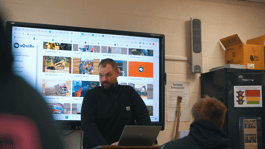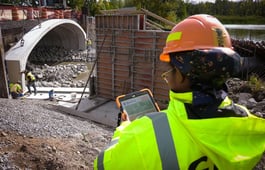What is Construction Microlearning?
Contrary to popular opinion, learning how to be a construction laborer or trades (wo)man is no longer boring.
Ever think about becoming an excavator operator, job site inspector, or electrician, but unsure of how to learn the trade?
Granted, learning construction is not easy. But what if I told you there's a more effective, fun, and engaging approach to learning about construction?
Imagine learning about construction in a school setting, meaning you'll be subject to rules, time constraints, and other conditions that can make your life miserable. Having flashbacks to your middle school days yet? We promise that the bully in history class won’t be waiting for you around the corner to try to steal your homework… or will he…
Now imagine learning about construction at your own pace, using engaging learning resources like videos and pictures. Even better, imagine learning from the comfort of your home, in your favorite chair, or at your kitchen table, watching your kids.
Like most people, you'll go for the second option.
Construction microlearning involves e-learning modules designed with the learner's needs in mind. The strategy leverages digestible chunks of content using engaging learning resources like videos, games, audio, pictures, and more. For example, instead of sitting down to read a chapter, you are now sitting down to watch a 4-6 minute video. These videos are hyper-specific and pertain to real job sites' projects, techniques, or equipment.
What's more, you can learn at your own pace, meaning your life doesn't stop because you're studying. As a result, it’s easier to maintain your full-time job, raise your kids, provide for your family, and attend that weekend football game… all while continuing to progress your talents, abilities as a worker and chance to be promoted to better-paying work.
Jobs that were previously considered "difficult" are now in high demand as a result. For instance, the construction job market is projected to grow by as much as 10% by 2024, according to the Bureau of Labor Statistics. This growth will be the fourth highest among major industries, such as IT and health business.
Technology also plays a significant role in the growth of the construction industry. For instance, construction learning apps and platforms like aQuiRe™ can help aspiring construction professionals learn about construction with minimal challenges. This article discusses why microlearning is becoming a preferred learning strategy for construction learning over traditional learning in a classroom.
Why Does Construction Learning Matter?
Construction learning requires persistence and effort. Learners must have the right mindset to grasp and retain important concepts they'll use later in their careers. An average construction student can take one year to learn the basics and four to six years to be a certified construction professional, as per Zippia. This construction learning period is relatively long considering the high demand for construction workers (thanks to the signing of the $1.2 Trillion infrastructure bill). This bill was passed to help the U.S. rebuild its infrastructure, specifically roads and bridges. However, construction workers must first learn certain skills to be competitive in their careers, including:
Construction Safety Rules
Understanding construction safety rules helps construction employees understand how to work in dangerous environments and handle hazardous materials. Basic construction safety rules include:
- Sorting out materials and keeping them safe
- Closing and fencing floor openings
- Waste management
- Removing obstructions from pathways
- Avoiding dark areas
- Being cautious when handling risky machines like drills and heavy equipment
- Avoid working while intoxicated.
Do you have safety training or toolbox talks for the hazards above? If not, contact us at info@cahilltech.com, and we have you covered!
Heavy Construction Equipment Operation
Most construction tasks involve working with heavy-duty equipment like bulldozers, loaders, tractors, and hand-held machines. Fully certified construction learning prepares workers to handle heavy-duty construction equipment and machinery. New learners are taught how to safely operate and handle construction machineries, such as cranes, drills, and others.
Manual Labor in Construction
Most successful construction professionals start at the bottom and learn the ropes on the job. Manual work is part of the learning process in construction. Common manual laborers include carpenters, artisans, builders, and more.
Robots have played a significant role in the construction industry in the 21st Century. For example, at Tesla's AI Day, Elon Musk’s Tesla unveiled the humanoid ‘Optimus robot'. The Autobot is expected to perform boring and dangerous jobs, such as moving heavy parts at Tesla factories. The innovation is to be replicated in other industries, including construction. Robotics is widely used in construction processes and pushing architectural limits.
Using robotics and similar technology, processes will advance faster and with minimal manual effort. The digital revolution has altered how construction professionals interact with technology by facilitating data, helping us build faster and safer.
What is Construction Microlearning?
Microlearning is learning through short, digestible, and practical learning resources to increase retention. However, learning a new skill can be frustrating and overwhelming if the wrong approach is adopted. A study by ResearchGate showed that the average learner forgets 70% of the learned content within a day and 90% of it in a week if they don’t strive to retain it.
Microlearning is the solution to learning retention. It is an avenue for adult learners to grasp project-specific, new information. Microlearning works well because it encourages users to watch videos and read content multiple times. The reading is short, engaging, and relevant. This promotes memorization when tied to the application.
Construction companies are using micro-learning to revolutionize their learning cultures, evoke curiosity and enhance engagement from the top down. Workers are encouraged to ask questions when they don't understand a project or instruction, versus being spoken to in a classroom all day.
Construction learning has moved away from traditional e-learning. Young construction workers say that e-learning is sometimes tedious and lengthy. The construction world enjoys learning by doing.
What are the Benefits of Microlearning
Why is Construction Microlearning Efficient?
Traditional learning involves achieving specific goals within a given timeframe. Courses are not easily accessible as workbooks or handout sheets. Micro-learning is readily accessible. Learners can take baby steps and learn at their own pace. Customizing content to suit a learner's needs introduces relevance. According to research, learners don't feel overwhelmed when using micro-learning techniques, significantly improving retention considering the attention span of an average student is 10 to 15 minutes.
Why does Construction Microlearning Increase Engagement?
Traditional educational content is typically long-formatted. It usually features text-based content, videos, or audio. Learners usually consume this content once, negatively impacting retention and application.
With microlearning, content is broken down into bite-sized chunks allowing the content to be consumed multiple times. Construction microlearning consists of short audio-visual graphics, e-books, and more. Various studies show that employees are more open to organizational learning tools that incorporate shorter courses.
How Do I Train Construction Workers with Needs-based Learning?
Traditional learning follows a specific predetermined path. Learners are considered to have similar needs or deficiencies, which could be accurate.
However, learners have different needs.
Self-directed learners can achieve their milestones without pressure, thanks to the self-paced nature of microlearning. With microlearning, learners and educators can identify skill set deficiencies, like technical knowledge or social-emotional skills.
Learners take short modules to address knowledge gaps. Once learners identify their weaknesses, the next step is to take the relevant lessons to improve. For instance, a student who lacks teamwork, communication, and interpersonal skills should focus on subjects or lessons that teach about soft skills.
Using the backend of the aQuiRe™ platform, educators or safety directors see how their contractors/students perform. Instead of playing the guessing game and assigning learnings based on gut feelings, you can best prepare learners using personal knowledge scores.
Using partnerships with organizations that value mental health, social-emotional learning, and communication, aQuiRe™ features free learning modules and content for teams looking to develop. Reach out to us with the subject line FREE CONTENT at info@cahilltech.com for free toolbox talks.
How Can I Train Construction Workers With a Flexible Learning Approach?
Today’s technology allows learners to access the content at their convenience, on their device, whenever they wish to learn, from any global location.
Microlearning is ideal for people with busy schedules or minimal time for learning new skills. Construction learning apps are designed for remote learning in the field while allowing learners to remain productive.
Will I See Increased Return on Investment with Construction Microlearning?
With e-learning, the following factors adversely impact learner engagement:
- Lack of time for training;
- The one-size-fits-all approach doesn't work for everybody
- Hands-off learning
These factors negatively impact engagement and ROI.
Microlearning is the best available option to combat the challenges of e-learning. Breaking down content into digestible bits that are accessible from anywhere at any time helps learners in the following ways:
- Increased concentration span
- Grasping complex concepts easily and faster
- Increased content retention
How Can You Learn About Construction?
Many aspiring construction professionals need clarification when learning about construction work. The main challenge is identifying the right studying resources.
Many sources, such as construction blogs and fake "construction experts," may provide incorrect and dangerous information to our industry. This leaves learners wondering whether to attend professional courses, read books, or learn from online blogs and articles. The following are sources we recommend to learn more about construction microlearning:
Construction Microlearning - Construction Projects
While trends have significantly changed in the construction industry, learning through on-the-job training remains one of the best ways for workers to retain knowledge. Construction management can use aQuiRe™ to assign microlearning modules to contractors. Your new contractors will learn construction basics, while seasoned vets receive refreshers to ensure safety.
Construction is broad, so you should niche education down to a preferred specialization.
aQuiRe’s™ library contains over 400 resources, videos, and tools that can be sent to contractors before a new job. This ensures everyone is on the same page with techniques or new tools they will use. In addition, microlearning helps keep construction safety on top of time- ensuring all employees follow safety protocol according to federal and state guidelines.
Construction Microlearning - Online Blogs
This construction learning option is budget-friendly, but it should be approached cautiously. There are many construction-focused blogs, but only a handful provide appropriate content for comprehensive construction learning. Learners should consider blogs that provide relevant, evergreen, and verifiable information. You should consult a construction expert to help identify appropriate and credible blogs.
Construction Microlearning - Industry Publications and Magazines
Construction publications come in different forms, including newsletters, magazines, and more. The benefit of this option is that the information comes from industry experts, authorities, and professionals. Some popular construction publications include Professional Constructor Central, Constructor Magazine, and Contractor Magazine.
Construction Microlearning - Youtube Videos
Learning through YouTube videos is an easy way to pick up new skills. Some people use YouTube to learn new trade secrets. Same advice here- use YouTube with caution. Always do your due-diligence on the people teaching you new skills!
Check out our YouTube channel to sample our content using the link above.
Finding an Accredited Construction Mentor
Experienced professionals may find value in passing on their skills to others. However, not all experts are good mentors or willing to share their knowledge. Finding a mentor can shorten the learning curve because mistakes are detected and corrected fast.
If you found someone whom you admire, or who holds a position that you would like to hold in 3-10 years, go out of your way to work with them. Volunteer on projects with them, take on extra work for them or ask them to lunch if you see they have forgotten theirs for the day. After working with this individual, if you still look up to them ... ask them to mentor you or work under them as their apprentice.
Traits to look for in a mentor: experience with hardship, patience, experience working with various ages, skill in managing -up and managing -down, passions outside of work, engagement with volunteer organizations, mission-based, morally aligned, memberships or board seats with organizations you admire, and educational accreditation.
It's okay, and important, to have more than one mentor. Each mentor should serve in a particular area of your life, either professionally or personally.
Takeaways
Construction microlearning is learning about construction through short, digestible, and practical learning resources. The goal is to increase learning retention and prepare a newer worker for the field. Aspiring construction professionals can learn about construction through different resources. Notable resources include blogs, online courses, YouTube videos, and publications. In addition, construction professionals and aspiring professionals can access free microlearning on aQuiRE and shorten their learning curve.



